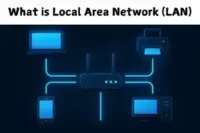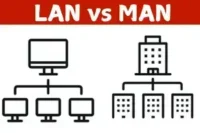What are the Advantages and Disadvantages of Metropolitan Area Network(MAN)?
Published: January 13, 2025
Are you struggling with slow internet speeds or poor connectivity in urban areas? You’re not alone! Many businesses and institutions face this issue, especially when their networks can’t handle the growing demands of modern technology. This is where Metropolitan Area Networks (MANs) can make a difference. However, before diving in, it’s crucial to weigh the advantages and disadvantages of Metropolitan Area Networks to ensure they address your needs effectively.
| What is the Metropolitan Area Network(MAN)? |
|---|
It is a high-speed network that connects multiple Local Area Networks (LANs) within a city or large area. It enables efficient data sharing and communication over metropolitan(urban) regions. |
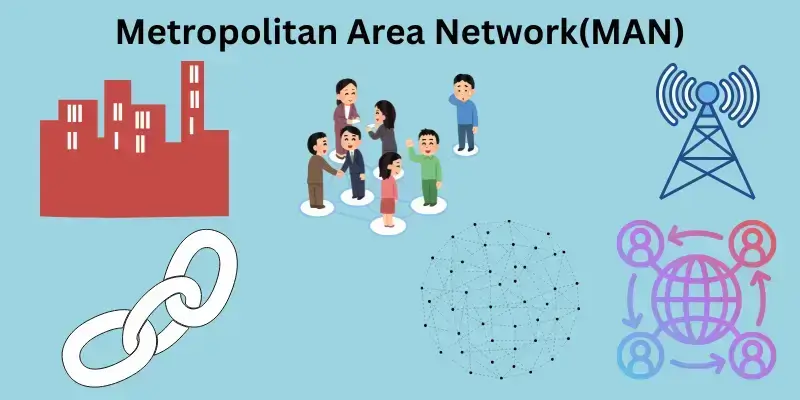
Advantages and Disadvantages of Metropolitan Area Networks (MANs)
Like any technology, they come with their pros and cons of Metropolitan Area Networks. Understanding these pros and cons is crucial when determining if a MAN fits your network requirements.
Advantages of Metropolitan Area Networks (MANs)
The pros of Metropolitan Area Networks (MANs) enhance connectivity, speed, and cost-efficiency, making them ideal for businesses needing seamless communication across multiple locations.
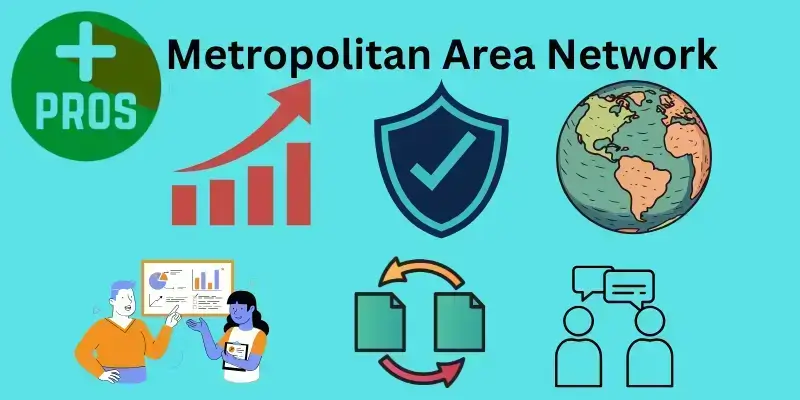
Here is the list of all the pros of Metropolitan Area Networks:
- Wider Coverage
- Higher Security
- Scalability
- Improved Communication
- Faster Data Transfer Speed
- Simultaneous Two-Way Data Transmission
- Internet Sharing
- Cost Savings in WAN Setup
- Centralized Management
- Strong Backbone Network for Large Systems
- Easy to Convert from LAN to MAN
Let’s learn how it makes it more manageable for us.
1. Wider Coverage
MANs provide connectivity across large geographical areas, such as entire cities or metropolitan regions, offering a broader reach than LANs.
2. Higher Security
With advanced security measures like encryption and VPNs, MANs provide a higher level of protection, keeping your data safe from unauthorized access.
3. Scalability
As your needs grow, MANs can easily expand to accommodate more devices or locations, ensuring you don’t have to worry about outgrowing your network.
4. Improved Communication
MANs make it simpler for people and devices across different locations to communicate quickly and efficiently, helping everything run more smoothly.
5. Faster Data Transfer Speed
Thanks to high bandwidth, MANs can transfer large amounts of data much faster, keeping your operations running without delays.
6. Simultaneous Two-Way Data Transmission
MANs allow data to flow in both directions simultaneously, making communication much more efficient and reducing wait times.
7. Internet Sharing
By connecting multiple locations, MANs make sharing a single internet connection easy, which can save costs for businesses or households.
8. Cost Savings in WAN Setup
Since MANs need fewer resources than WAN, they can help reduce the overall costs of setting up a large-scale network.
9. Centralized Management
With MANs, you can manage and monitor the entire network from one central location, making it much easier to keep things running smoothly.
10. Strong Backbone for Large Networks
MANs act as a sturdy foundation for larger networks, making connecting smaller LANs easier and ensuring seamless data flow across the whole system.
11. Easy to Convert from LAN to MAN
Upgrading from a Local Area Network (LAN) to a Metropolitan Area Network (MAN) is a relatively simple process, giving you the flexibility to expand your network when needed.
Disadvantages of Metropolitan Area Networks (MANs)
Metropolitan Area Networks (MANs) cons include higher setup costs, security risks, and the need for skilled technicians. These challenges must be weighed when deciding if a MAN suits your needs.
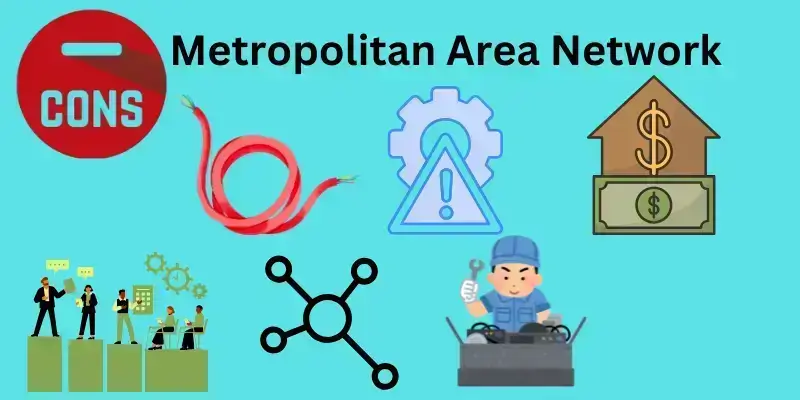
Here is the list of all the cons of Metropolitan Area Networks:
- Required wires
- Security Risks
- Higher Costs
- Difficult to manage
- Limited Connectivity
- Need for Skilled Technicians
Let us know in detail about these cons of Metropolitan Area Networks.
1. Required Wires
While MANs offer many advantages, they also require a lot of physical cabling to connect different locations. This can make the setup more complex compared to simpler networks like LANs.
2. Security Risks
Because MANs cover larger areas and involve multiple connections, they can be more exposed to potential security threats. Hackers may see these networks as more appealing targets, so extra care is needed to keep everything secure.
3. Higher Costs
A MAN can be pricey to set up and maintain. With more infrastructure needed, the costs can stack up, especially compared to a smaller network like a LAN.
4. Difficult to Manage
Managing a MAN can feel like juggling multiple balls at once. It involves a lot of different connections and users, and making sure everything runs smoothly can be tricky without a good management plan in place.
5. Limited Connectivity
Although MANs can cover a large area, they still have their limits. If you’re in a more rural or remote area, the network doesn’t reach as far as you’d like.
6. Need for Skilled Technicians
Setting up and managing a MAN isn’t something just anyone can do. You’ll need experienced techs and network administrators to ensure the system works properly, and that expertise can add to the overall costs of installation and maintenance.
| Difference Between Advantages and Disadvantages of Metropolitan Area Network(MAN) |
|---|
| Aspect | Advantages | Disadvantages |
| Coverage | Covers large areas like cities or regions, ensuring better connectivity. | Doesn’t always reach rural or remote places. |
| Speed | Transfers data quickly with high bandwidth, keeping things running smoothly. | It can slow down if the network isn’t managed well. |
| Security | Offers better protection with tools like encryption and VPNs. | Larger coverage makes it more vulnerable to hackers. |
| Cost | Saves money compared to setting up a WAN. | Setting it up and maintaining it can be expensive. |
| Management | You can control and monitor the whole network from one place. | Managing a complex setup can get tricky. |
| Resource Utilization | Let data flow both ways at the same time, making things efficient. | Needs a lot of cables, and setup can be time-consuming. |
| Adaptability | Simple to upgrade from a LAN to a MAN as your needs grow. | Gets more complex as the network expands. |
Wrapping Up
To sum up, understanding the advantages and disadvantages of Metropolitan Area Networks is important for any organization considering this type of network. It helps to know the good and bad points before deciding if it’s the right choice. If you prioritize high-speed connections and scalability, a MAN could be an excellent choice, but be prepared for the complexity and costs involved.
My recommendation is to assess the long-term benefits and potential challenges before making a decision. If you think a Metropolitan Area Network could be a good fit, contact professionals to help you navigate the setup and management.
FAQs About Advantages and Disadvantages of Metropolitan Area Network(MAN)
A Metropolitan Area Network (MAN) is a network that covers a larger area than a Local Area Network (LAN) but is smaller than a Wide Area Network (WAN). It connects multiple buildings or areas within a city. It allows for fast data transfer between connected locations.
Some benefits of a MAN include faster data speeds, a larger coverage area, and lower costs than a WAN. It helps businesses share resources easily, like printers and files. It also offers strong security and reliable connections.
Some downsides are that it can be expensive to set up, requires more cables, and needs skilled technicians. Also, managing a large network can be difficult, especially when it grows. Security risks can also increase as the network expands.
A Local Area Network (LAN) is smaller and usually covers a single or small group of buildings. A MAN, on the other hand, connects multiple locations within a city. MANs offer wider coverage and are typically faster than LANs.
MANs are better for connecting locations within a city, while WANs cover much larger areas, sometimes even across countries. MANs offer lower setup costs and are more reliable for local businesses. However, WANs are better suited for global communication.
Yes, a MAN can provide internet access to multiple buildings or locations in a city. It helps businesses share resources like internet connections without needing individual connections for each location. It makes internet access more efficient and affordable.
A MAN can be quite secure, especially when using VPNs to protect data. However, because it connects multiple locations, there is a higher risk of cyber-attacks than smaller networks like LANs. Proper security measures are needed to keep the network safe.
Yes, MANs are scalable, meaning they can grow to include more buildings or areas as needed. Adding new locations or users is usually simple and cost-effective. It makes MANs ideal for businesses that are growing.
Converting a LAN to a MAN is relatively easy because both networks use similar technologies. However, the setup will require additional cables and equipment to connect multiple locations. It’s best to work with experts for a smooth transition.
Setting up a MAN can be costly, especially when considering the need for additional equipment, cables, and skilled technicians. However, compared to a WAN, the cost is generally lower. Over time, businesses save money on individual internet connections and resource sharing.
A Metropolitan Area Network (MAN) covers a city or metropolitan region, connecting multiple LANs for city-wide communication. For localized data sharing, a Campus Area Network (CAN) is smaller and covers a specific area like a university or office campus.
Common types of malicious attacks on networks include phishing, malware (viruses, ransomware), Denial of Service (DoS) attacks, man-in-the-middle (MITM) attacks, and data breaches, all of which can compromise network security.
A Metropolitan Area Network (MAN) uses the five layers of the TCP/IP model to enable data transmission, routing, and reliable communication across cities. Each layer, from physical to application, plays a role in ensuring efficient connectivity within the MAN.
Backbone cables in a MAN help transmit large volumes of data across the city, ensuring high-speed and reliable communication between local networks.



